For all the effervescent propaganda it cranks out, the federal government is curiously reluctant to tell the exploited tax slave what it all costs. The same grateful government that will pay disabled Canadian soldier (and father of five) Garry Dolphan a $14,000 yearly pension for the broken back he suffered during a line of duty parachute jump, is unperturbed by the fact that “a refugee costs the taxpayer at least $50,000 a year.” (Diane Francis, National Post, April 24, 1999) While our refugee acceptance rate stands at a beyond-gullible 84%, “Britain last year rejected 76% of asylum applications.” (The Economist, February 20, 1999)
Interview — Dr. Maria Hugi

Poor Screening of Immigrants Poses Serious Health Hazard, Says Vancouver Doctor
A powerful immigration lobby and weak, rudderless government officials are endangering the health of Canadians, a Vancouver doctor charges. “Immigrant and refugee lawyers are fuelling this corrupt system. All they want to do is line their pockets. They think nothing of protecting the health of Canadians,” she says. “We out here in the Vancouver emergency departments, are still reeling from the social toll taken by your recent tragic lack of screening of the Honduran refugees who entered the country in August, 1998,” Dr. Maria Hugi told Immigration Minister Lucienne Robillard in a Feb. 4 letter.
The Swiss-born, Vancouver-raised doctor knows what she’s talking about. She herself caught TB while resuscitating a Burmese refugee. “If I was so easily infected with 30 minutes or less exposure, then almost anyone he was in contact with could have had it with no idea that they had been exposed. This is truly a public health nightmare,” she told the Canadian Medical Association Journal (April 20, 1999) Unlike the all-too-typical Canadian who takes his lumps from an uncaring system and slinks away silently, Dr. Hugi chose to speak up.
National immigration lawyers meeting, November 30, 1998
In her letter, the spirited 40-ish doctor explained the health chaos caused by allowing in a horde of self-styled Honduran “refugees.” “The other day, one of my colleagues treated a Canadian woman whose jaw had been broken by a Honduran refugee.
Last week, I treated a young 19-year old Honduran refugee, 36 weeks pregnant who would have been admitted to Canada on August 5, 1998 and who had received no prenatal care until I saw her. Needless to say, she had to be admitted to hospital (her blood count was dangerously low) and, after calling three hospitals, I finally managed to find her a bed.
Through an interpreter, she kept insisting that she was 20 weeks pregnant and that her last menstrual period occurred after she entered Canada. In addition to screening refugees for communicable diseases, pregnancy screening might be warranted for young refugees so that we can offer them good prenatal care, so vital to the well-being of the mother and baby.”.
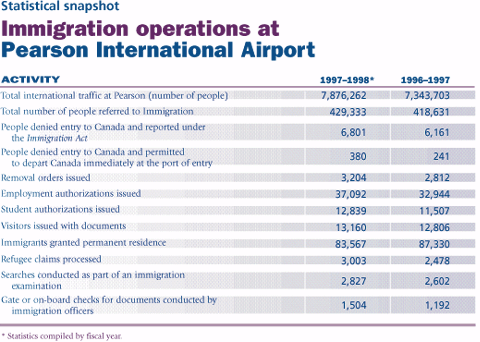
THE FIGURES SAY IT ALL — OF NEARLY 8 MILLIONS, JUST 380 ARE TURNED AWAY AT OUR GATES
- Illegals First; Taxpaying Canadians Last
This Honduran peasant girl who spoke no English, thus, got a scarce bed and some lady who was a third generation Canadian, with an injured back, was sent home. In an interview with the Canadian Immigration Hotline, Dr. Hugi charged: “People who’ve paid into the system are turned aside in this irrational system in favour of people who’ve never paid a dime.” Dr. Angus Rae is a neurologist at St. Paul’s Hospital in Vancouver, Dr. Hugi explains. He has complained about desperately ill foreigners being put on dialysis which is “hideously expensive.”
Because of the urgency of their need, “they jump the queue, even though they’ve never paid taxes here. When they let in drug-running gangsters from Honduras, there’s a social cost,” Dr. Hugi emphasizes. “If I need my hip replaced, I mightn’t get it because some drug addict needs his valves replaced.”

- TB: We’ve Let Our Guard Down
Dr. Hugi tells of an immigrant student at Simon Fraser University with full-blown tuberculosis. The costs of this lapse of government screening was that “they had to check 450 people the student had come into contact with.” Foreign “students are not screened very well,” she observes.
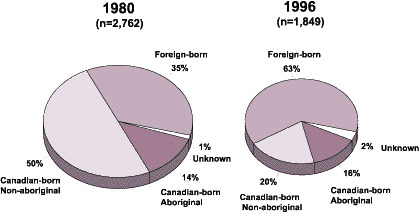
Distribution of New Active and Relapsed Tuberculosis Cases by Origin – Canada: 1980 and 1996
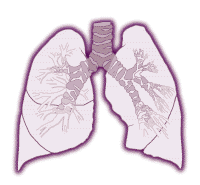 “The best thing ever to happen to TB is AIDS. We’ve let down our guard. TB is the number one killer in the world,” and, thanks to lax screening and an indifferent government, it’s heading our way. The doctor illustrates the problem of the lax screening of immigrant students with the story of a doctor friend of hers who treated an infant from sub-Saharan Africa who had rampant AIDS. “The parents refused to be HIV-tested,” says Dr. Hugi. “They were visa students.”
“The best thing ever to happen to TB is AIDS. We’ve let down our guard. TB is the number one killer in the world,” and, thanks to lax screening and an indifferent government, it’s heading our way. The doctor illustrates the problem of the lax screening of immigrant students with the story of a doctor friend of hers who treated an infant from sub-Saharan Africa who had rampant AIDS. “The parents refused to be HIV-tested,” says Dr. Hugi. “They were visa students.”
“When we think of AIDS, we think of TB,” says Dr. Hugi. the indiscriminate use of antibiotics in Third World countries has led to drug resistant TB. “Southeast Asia and the Philippines is where TB became drug resistant.” Russia is another medical timebomb. “They’re not immunizing people for diphtheria anymore in Russia. They really need to screen those Russian immigrants,” she warns. Health Checks Penalize First World Immigrants
Ironically, says Dr. Hugi, health checks penalize First World would-be immigrants. “If you’re an immigrant from Sweden, the U.S., or Switzerland and you have hypertension or high blood pressure, your detailed medical history will document it. Forget about getting in here.” On the other hand, in Third World lands, she explains,. “there’s a black market in chest x-rays and clean bills of health.
We should send Canadian doctors who can’t be bought to test would-be immigrants,” she advises. “There are just no teeth to refugee health checks in Canada,” she charged. “Those who come without documents to the U.S. are put into holding tanks and sent back!” Reported New Active and Relapsed Tuberculosis Cases by Age Group and Origin – Canada: 1996 “Magnanimous Canadians who take refugees into their homes aren’t told that many refugees have contagious diseases. These people are putting their families at risk,” Dr. Hugi warns.
| * “THE ISSUE OF TUBERCULOSIS SHOULD NOT BE A REASON TO RESTRICT IMMIGRATION” * “MINISTER ROBILLARD WILL NOT SACRIFICE THE HEALTH AND SAFETY OF CANADIANS FOR ECOMONIC BENEFIT” |
- Mother Nature is Ruthless
“I’m looking at this in a very practical, scientific way. The only reason we don’t have Gypsy Moth infestation here is we have very strict screening of plants and fruit.” It’s the same with heartworm in pets. There’s a very strict regime of quarantine of pets coming in, she explains. “We’re ruthless with trees, livestock, or pets, but we’re muddled when it comes to humans.” “Mother Nature is ruthless. She’ll infect you with TB, if you get in the way,” she warns. “AIDS has set us back 100 years in terms of good public health practices. Do you think Mother Nature gives a damn about the AIDS lobby?” she asks. The situation of the Honduran “refugees” is a farce.
Dr. Hugi explains that since 1996, when the U.S. began detaining illegal refugees, the numbers of Hondurans dropped from 100,000 a year to 25,000. When the Hondurans started pouring across the Texas border, the Americans set up detention tents, and the influx stopped. Now illegals are detained for 10 days, If their claim seems credible, they’re released on bond. In Canada, in most cases, they’re just released until their hearings. Other dread diseases are making a comeback in part, thanks to lax immigration screening. “Syphilis is coming in from Southeast Asia,” says Dr. Hugi, “carried by people coming back from Southeast Asian sex trips. The Thais really sell their young — sacrificing their kids to the sex trade.”
- Little Sympathy from the Government
Dr. Hugi has had to submit to an intense regime of drug treatment for the TB she contracted. She counts herself lucky that it was not the drug-resistant strain. However, she received scant sympathy from officials at Citizenship and Immigration Canada. She sent two letters about her concerns on June 20 and October 1, 1998 to the Immigration Department. Not until December 2, nearly six months after the first letter, did Joan Atkinson Director General of the Selection Branch of the department bestir herself to reply. Clearing away the tangled verbiage, Atkinson essentially said that emergency room work is a high risk profession: ‘them’s the breaks’ and, anyway, refugees and immigrants are not to blame. “Health risks … are an essential element of such work and are not posed by one particular client group.
Canada is, I believe, justifiably proud of its stance with regards to providing a safe haven for persons at risk of persecution. All immigrants, including overseas refugees selected abroad, and certain visitors are required to undergo an immigration medical examination prior to entering Canada. … All in-Canada refugee claimants [illegals who designate themselves are ‘refugees’ once they’re here] are required to undergo an immigration medical examination and requested to do so within sixty days of such a claim. Furthermore, there are provisions for not only the immigration medical examination fees to be paid by this department, but also any required emergency and essential health care for those in-Canada claimants who lack the financial resources to pay for same.”
Atkinson used the obfuscating dodge of “privacy” to thwart Dr. Hugi’s inquiries into the exact status of the Burmese AIDS patient who had infected her with TB and subsequently died. “If your patient was an in-Canada refugee claimant, then he would have been referred for medical examination after making his refugee claim. If, as a result of this medical examination, tuberculosis was suspected, appropriate referral for investigation and treatment would have followed. … Medical confidentiality prevents the identification of the individual about whom you write.
Without specific knowledge of this person it is impossible to determine his immigration status.” [Other than the fact that he is currently dead, and, presumably, no longer entitled to privacy!] The letter illustrates Dr. Hugi’s complaints about Canada’s toothless policies. A self-proclaimed refugee may be asked and advised to go for a health check, but failure to do so does not result in removal. A desperately ill person may be “referred” for treatment, which the Canadian taxpayers pay for, but this costly and often contagious person is not removed and no consequences follow his not taking the treatment that is advised.
Oh, Those Gay Immigration Rules
“The definition of gay partnership is bedevilling federal immigration officials. … The difficulty stems from the fact that Immigration Department officials cannot find a foolproof way for gays to prove they are in a legitimate spousal relationship before coming to Canada … [in] countries and cultures that discriminate against gay relationships.” (Globe and Mail, May 22, 1999) Over the past year, we have run numerous accounts of Latin American lesbian, homosexual and transvestite travails. Guess what? According to the International Gay and Lesbian Human Rights Commission, “the governments of Chile, Nicaragua, and Puerto Rico [surely an 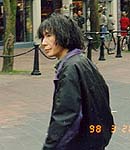 American concern?] … are the last states in the Latin America [sic] that still criminalize homosexual activity.” (News, December 1997) Does Immigration Canada know? By June 10, 1999, however, the front page of the Globe and Mail is crowing: “Most in poll want gay marriages legalized — 53% support idea despite MPs.” What we have here, is the Thin Red Line of MPs standing between the majority of Canadians and their fondest wish — homosexual marriage. Gosh, how long can the breathless suspense last? (Similar polls on immigration are promptly deep-sixed).
American concern?] … are the last states in the Latin America [sic] that still criminalize homosexual activity.” (News, December 1997) Does Immigration Canada know? By June 10, 1999, however, the front page of the Globe and Mail is crowing: “Most in poll want gay marriages legalized — 53% support idea despite MPs.” What we have here, is the Thin Red Line of MPs standing between the majority of Canadians and their fondest wish — homosexual marriage. Gosh, how long can the breathless suspense last? (Similar polls on immigration are promptly deep-sixed).
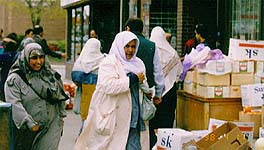 .
.
CFRIC’s Immigration in Pictures to see the effect of immigration on Canadian cities
The Harlot’s Progress

Thank you for choosing Canada!
The May 31, 1999 edition of Time (Canada) magazine devotes no fewer than 20 pages to our changing demographics. The subtext, as always: “Resistance is futile”. At the outset, we are reminded that Canada is “a community that prides itself on consensus problem solving.” Only a nation that routinely pepper sprays, shushes, and shoves dissenting opinion before the bench would think so — or have we simply forgotten voting ourselves into despised minority status? The article goes on to confide: “Canada’s birth rate declined 25% from 1980 to 1998, to 11.5 births per thousand. … Canada’s growth now is fuelled by an influx of new citizens, at rates unmatched since the [massively underpopulated, pre-handout] days of Prime Minister Sir Wilfrid Laurier.” As with all such tall immigration tales, Time neglects to mention Ottawa’s very many failures to implement the birth-friendly policies that just might have ensured the survival of a distinctly Canadian people, gushing instead over strategies which can only guarantee that our last moments before summary replacement be just as unpleasant as possible. Yet, as long ago as the settlement of New France, early marriage and population growth was a well-subsidized priority.
For instance: “Young men who married at 20 years or younger and girls who married at 16 years or younger each received 20 pounds on their wedding day. A yearly pension of 300 pounds was given to families of ten living children and 400 pounds to families of twelve or more children.

Finally, some community duties — church warden or militia captain, were as much as possible given to fathers of large families.” (Museum of New France, October 1997) The result: Habitant birth rates soared to 65 births per 1,000 (Compare above.). Today, “women simply can’t afford to stay out of the work force. … Just over one in twenty youngsters in dual-income homes lived in poverty, compared with one in four in families relying on one wage.” (Globe and Mail, August 27, 1997) This is a situation that has subsequently worsened.
Again, Canadians lose. Child care is cruelly expensive — unless you import an elderly child-minding relative. Just beneath the surface of Time’s gee-whiz coverage lurk the unpleasant realities of “mass enrichment”. “The pull of ethnic apartness is strong. … Amir Hassanpour, a research associate at the University of Toronto who specializes in media studies, says that … the pattern of assimilation has all but disappeared. … The Toronto city clerk’s office, for example, offers phone translations in no fewer than 148 languages. … Many families can seek out their ethnic community upon arrival and raise their children in their mother tongue. As a result, [head of Toronto District School Board, Gail] Nyberg says, more and more children born in Canada are arriving in kindergarten not speaking English. [This rejection of the prevailing tongue naturally translates into a condemnation, not of those who do not bestir themselves to learn, but of the tax-slave who simply cannot cough up even more ‘special needs’ funding. And the article obliges.] … This is happening at precisely the time when provincial governments in Ontario and elsewhere have slashed funding for English-as-a-Second-Language programs. Ontario once offered five years of ESL. B.C. offered 12.
They are now down to three years and five years, respectively. Pat Mitchell, principal of the Vancouver Technical School … says five years is not even close to enough time to learn a new language well.” Really? Ontario used to think so, or is the entire hare-brained scheme so essentially hopeless that it ought to be scrapped? As Toronto and Vancouver (the current immigrant magnets) go, so goes the country. “By 2,005, 1 in 4 Calgarians will be from a minority group. … The big problem is figuring out who needs what. Mexicans and Central Americans suffer from unusually high unemployment rates. Vietnamese immigrants, on the other hand, have difficulty with the school system. Fewer than 50% will get a diploma. ‘Some people,’ sums up Mike Ornstein, a York University sociologist, ‘are more diverse than others.’ So that’s what it’s called. But Canadian officialdom is fiercely determined that unfamiliarity with, or rejection of, our language and mores is the fast-track to local riches. Yes, “new” people need cars and toaster-ovens and bicycles, but as B.C. has discovered, it’s no substitute for a real economy.
“New Brunswick recently signed a deal with Ottawa to bring in 200 immigrants a year, whose only admission criteria, aside from health and criminal-record checks, will be that they want to live in the province. [This despite the fact that ‘the Atlantic Provinces Economic Council reports about 4,300 people between the age of 20 and 29 left New Brunswick from 1991 to 1996.’ Not that it matters: Replace ’em!] … The city [of Brampton] offers tax breaks and other incentives to business start-ups, which is directly supportive of efforts by new entrepreneurs to strike out on their own as soon as possible,” the abysmally short life span of the average small business in Canada notwithstanding.
Hey, we’re tracking ‘business s tart-ups’ here; ‘business shut-downs’ are the landlord’s and supplier’s problem. “The Royal Bank of Canada “has not only used the principles of feng shui, or Chinese geomancy, in new bank designs … but has also adopted a policy of avoiding ‘unlucky’ numbers like four in addresses and account numbers while giving priority to ‘lucky’ numbers, like three and eight.” For all of us — or just ethnic Chinese? Can voodoo dolls for new customers be far behind? What are some of the other benefits accruing to an
tart-ups’ here; ‘business shut-downs’ are the landlord’s and supplier’s problem. “The Royal Bank of Canada “has not only used the principles of feng shui, or Chinese geomancy, in new bank designs … but has also adopted a policy of avoiding ‘unlucky’ numbers like four in addresses and account numbers while giving priority to ‘lucky’ numbers, like three and eight.” For all of us — or just ethnic Chinese? Can voodoo dolls for new customers be far behind? What are some of the other benefits accruing to an 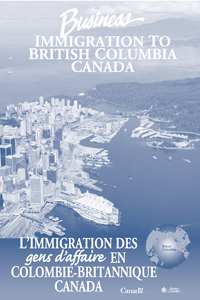 increasingly fragmented people, as Time describes us: “living side by side but not together”. Despite the wailing and rending of garments, we learn that even the definition of “hate crime” is changing.
increasingly fragmented people, as Time describes us: “living side by side but not together”. Despite the wailing and rending of garments, we learn that even the definition of “hate crime” is changing.
“In Toronto, reports of such crimes are down to 92 in the first half of 1998, from a peak of 302 in 1995, … though the incidents are often within, rather than between, ethnic groups. (The most recent example: the Vancouver assassination of Sikh editor, Tara Singh Hayer) … [Or partisan,] a Serb parent filed a hate-crimes complaint against a teacher who offered an opinion in a history course about Yugoslavia with which the parent disagreed.” In a bit of fun, the Privy Council report on Canada’s future, perceives “signs of strain. The report cites research suggesting that declining faith in government and voluntarism may be partly due to increasingly varied viewpoints in society. … As Canada enters a new century with its doors [some would say legs] flung wide open, the issue may soon be turned on its head: not how immigrants accommodate to Canada, but how immigrants accommodate themselves.” In which case, they’d better look again; the future is here.
BE SURE TO WIPE YOUR FEET!
Minorityitis: Guess Who’s in Charge?
Extended care facilities across B.C. must have broken out the champagne and glass straws to celebrate this one. “A British Columbia law requiring motorcyclists to wear a helmet discriminates against Sikhs who wear turbans, the B.C. Human Rights Tribunal [as personified by Frances Gordon] has ruled. … Avtar Singh Dhillon, who is in his fifties, filed a complaint with the tribunal four years ago.” (Globe and Mail, May 15, 1999)
Whatever Happened to St. Pats?
Remember the TB scare at Ottawa’s St. Patrick’s Adult Day School [Hotline #102]? Well, the joint’s been closed, along with three other ESL schools — and Robert Courchene is spitting nails. Just coincidentally, he’s the president of the Teachers of English as a Second Language Association of Ontario. “In justifying their decision, the trustees … insisted that their jurisdiction was in the K-12 area and, as they did not receive any funding for spaces occupied by adult learners, they could not keep the schools open.” (Ottawa Citizen, March 31, 1999) Hey, let’s take bread right out of the mouths of children and give ESL students a free lunch!
Wear, Tear, and Deferring Repair
After many years of behaving as though the world revolved around it, Toronto has realized its fondest wish. Okay, it’s the Third World, but what the heck? “Visible minorities, moreover, are already in the majority, and will reach 54% of the Toronto population by next year.” (Time, May 31, 1999) As we (and they) are incessantly reminded, the annual inpouring of 70,000+ immigrants bringing attendant specialized needs and proportionally higher use of social services represents a net gain! In the same way, when the city groans and begins to come apart at the seams, it’s character! Infrastructure just isn’t sexy, is it? If urban planner, Joe Berridge is right, there’s worse to come. “We have been lucky — a relatively young postwar city in infrastructure terms still well served by a legacy of good public investments in the 1960s and 1970s. We have been the peaceable kingdom. Without underplaying the historical social tensions in U.S. cities [we’ve been importing tensions for years — we’re real players now!], part of the reason for their precipitous decline in the 1970s and 1980s is that they were just a generation older than we were. The deadly combination of deferred maintenance and ageing physical plant that laid them low is now emerging in Toronto. …
The port, the older industrial sections of Scarborough and Etobicoke, the arterial corridors of the inner suburbs, parts of the east downtown, the cores of older urban centres now incorporated in the city region, the concentrations of public housing, the decaying stocks of 1960s apartment buildings — all of these border on the spiral of decline once so visible in U.S. cities. … Sadly, we have few if any infrastructure projects that speak to the city-region’s future. … The condition of roads and bridges steadily deteriorates: In 1997, the city’s works department estimated $40-million in essential rehabilitation had been deferred. The budget seems to have no room for water-quality or environmental improvement. … [It is precisely quality of life issues that ought to dominate discussion in a community undergoing rapid population expansion, but we get to feast instead on a steady diet of anti-racist, anti-smoking, anti-hetero diatribes]. … The City of Toronto’s ability to meet its operating obligations, let alone new capital initiatives, is extremely limited. … [When] business in the Golden Horseshoe … accounts for half the province’s economy — and almost one-third of the nation’s. [Curiously, a pattern that is neatly replicated in immigration settlement patterns] … If we’re so smart and so rich, why is our city so broke?” (Globe and Mail, June 7, 1999) Careful there, Mister, we’re not broke — we’re enriched!
Ancient Computers Hobble Immig. Debt Collection
“A bug-riddled computer system from the 1970s has severely hampered the Immigration Department’s ability to collect millions in overdue loans. The outmoded technology has churned out incorrect account balances, mangled vital data and created processing delays of several months. As a result, $28-million dollars worth of overdue accounts have not been pursued since 1995.” (John Williams, MP, The Waste Report, June 1999) As Maria Minna, parliamentary secretary to the Minister of Citizenship and Immigration, must have been very well aware as she sang loan programme praises to Parliament: “The government has a loans program which is very effective. In fact, it helps at least 95% of refugees and people who come to this country. We also have a very high payback, 92%. It is a program that works very well for refugees and immigrants coming into this country. It is very effective.” (Hansard,, November 28, 1997) Who’s numbskull idea was this one?
How Did We Get So Lucky?
Escobar Family Moves In “The family of the late [as of a 1993 shootout] Pablo Escobar, the notorious South American cocaine baron, has been allowed to relocate in Canada, according to his brother [who is] serving a life sentence for drug trafficking. … An Immigration Canada spokesperson said the department could not comment on specific cases without the permission of the family involved. … ‘Unless there’s been a public procedure involving these people, there’s no way we can comment because of the Privacy Act.’ … If they landed as refugees, [Forbes once ranked him as the world’s richest criminal] any hearings would be held behind closed doors. … Bogota sources say Canada and Colombia struck an agreement a year after Escobar was killed. Members of his family, who were being threatened, were given new names and a witness protection deal without being obliged to co-operate with justice authorities.” (National Post, June 3, 1999)
Some People Are Accident Prone
It read like a script out of Monty Python, but the laugh was on the poor British taxpayers and sundry insurance companies. As model immigrant households do, the Sharif family resolved to make its own luck. “It began in September 1990 when [shopkeeper Mohammed Sharif, 58 — fresh from a five year jail term for torching his shop — ran over his son, Arif. Then, in quick succession, came injuries to daughters Parveen (twice), Yasmin (twice) and Razia, along with son-in-law Abdul Raschid. Razia Ahmed, 26, and her brother Mohammed Zulfiqar, 28, … claimed to have been turned into a vegetative state as a result of their accidents. … Despite claiming to be confined to a wheelchair [Ahmed] was well enough to give birth four times — the latest arrival came during the eight-week trial. Zulfiqar was still pursuing a £1.75 million insurance claim at the time of his arrest. … Even in the dock, he remained so determined to maintain the pretence of being incapacitated that he continually nodded and shook, occasionally soiling the nappies provided for him.
 Videotape of Zulfiqar working out “between diaper changes” …
Videotape of Zulfiqar working out “between diaper changes” …
The jury was shown a video tape of him driving a car and working out on a multi-gym. … Abdul Raschid, 22, who claimed to have been crippled in an accident, was filmed riding a donkey, his arms outstretched. … The trial had finally got under way after seven attempts, with the defendants feigning illnesses. … The family claimed during their trial that investigators had mistaken Zulfaqir for a cousin. … Similar cases of mistaken identity had also put Parveen and Razia in the dock. … They had made successful claims of £230,000 and at one stage were claiming £1,675 [$3,903 Cdn] a week from the benefits [welfare] system alone. … The game was up when insurance companies finally twigged that whatever car Sharif was driving … one or more of his relatives would end up spread-eagled over the bonnet or under the wheels. … Detectives believe the Sharifs avoided detection for so long by exploiting the gullibility of consultants and pretending to be unable to speak English.” (London Telegraph, March 24, 1999) Postscript: “Nine members of one family were jailed yesterday. … The court was told that the day after the arrest some of the conspirators managed to transfer £211,000 from British banks to banks in Pakistan. This money has never been recovered. … The ringleader, Mohammed Sharif, of Ribbleton, Preston, Lancs, died of a heart attack two weeks ago after turning down the chance of a triple bypass operation. … He told doctors that he no longer wanted to go through with the operation ‘because of the risks.'” (London Telegraph, May 22, 1999)
Many of Jamaica’s Worst Criminals Are Abroad
With each passing year, the annual donnybrook known as the NAC lobby session draws ever fewer masochists from the parliamentary pool of pampered pols. Delegates from the minority rich National Action Committee on the Status of Women predictably bullied, heckled and hissed the 15 MPs who did show up. NAC president Joan Grant-Cummings accused the Liberals of “waging a war of ethnic cleansing against Jamaican-Canadian men. … Ms. Grant-Cummings [just coincidentally black herself], also demanded the government repeal dangerous-persons deportation provisions within the Immigration Act because they unfairly target black men in Canada. … ‘It was brought in with very racist sentiment in our opinion about how some Canadians feel about black Jamaicans. …
This has been about cleansing the whole Canadian population.'” (National Post, June 8, 1999) The provision was made in 1994, after a non-citizen black man shot 23-year-old Georgina Leimonis in the chest during the Just Desserts robbery. Was Ms. Grant-Cummings equally unaware of Jamaican prime minister P.J. Patterson’s June 4th comments in Toronto;, or did she merely hope no one else was? Addressing a crowd of “Jamaican nationals, the Prime Minister also touched on the smuggling of weapons into Jamaica, saying that ‘most of the guns and ammunition originates from pockets of the Jamaican community resident overseas.'” (Pride, June 10-16, 1999) Does Ms. Grant-Cummings also consider it racist that “the Jamaican government has passed a law to monitor deportees convicted abroad of certain major crimes …
Over the last few years, Jamaican police have blamed some returning deportees for committing serious crimes, selling drugs and illegally importing firearms.” (Toronto Star, July 1, 1997) Another example of NAC nuttiness: When Liberal backbencher Albina Guarnieri succeeded in winning Commons approval for a bill allowing judges to sentence multiple killers or rapists to consecutive sentences, NAC fumed, arguing “the bill will disproportionately affect those who ‘are already criminalized, mainly non-white economically disadvantaged people.'” (Toronto Star, June 8, 1999) At last report, neither Paul Bernardo nor Clifford Olsen, serial killers both, were known to be non-white!
A Picture Of Vancouver


 The Globe and Mail of June 7, 1999 published a profile of Vancouver’s Chinese community within the demographic landscape. It’s largely an act of faith to contrast those who listed their ethnicity as “Chinese” in the last census with those who checked “Canadian”. Since the ethnicity question was both self-designated and contentious at the time, we have little assurance that statistical “Canadians” conform to traditional notions. But, for what it’s worth, it knocks the pins out from under some cherished stereotypes: “one notable difference in the census was the discrepancy between the unemployment rates in the two communities.
The Globe and Mail of June 7, 1999 published a profile of Vancouver’s Chinese community within the demographic landscape. It’s largely an act of faith to contrast those who listed their ethnicity as “Chinese” in the last census with those who checked “Canadian”. Since the ethnicity question was both self-designated and contentious at the time, we have little assurance that statistical “Canadians” conform to traditional notions. But, for what it’s worth, it knocks the pins out from under some cherished stereotypes: “one notable difference in the census was the discrepancy between the unemployment rates in the two communities.
Among the Chinese, the rate in 1996 was 9.6 per cent, while it was 7.5 per cent among the city’s Canadians. The gap baffles many observers … is it a linguistic issue? The census said 53,520 Vancouver Chinese spoke neither English or French that year. … In 1996, 78% or 219,865 Chinese were born outside Canada … Almost half who immigrated arrived between 1991 and 1996 — some 99,960 people. Another wave took place between 1981 and 1990, with about 62,710 people arriving.” Those who arrived before 1961 constitute just 3% of Vancouver’s Chinese population — 5,885 people.


